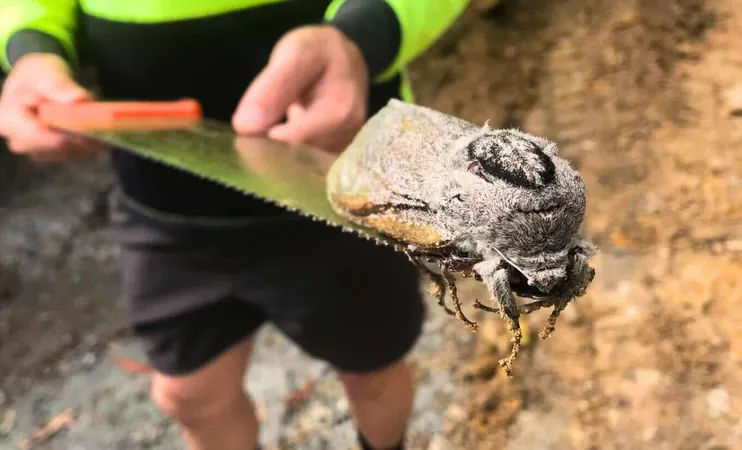
Giant Wood Moth Spotted in Queensland: Meet the Massive ‘Rat-Sized’ Wonder!
2025-03-12
Author: Ken Lee
Australia is continually on the edge of wildlife discovery, boasting everything from massive sharks to extraordinary birds. Recently, a surprising find in Queensland has turned heads: construction workers stumbled upon a giant wood moth at Mount Cotton State School, a creature so immense it was dubbed the size of 'two fists put together.'
Located near a rainforest, Mount Cotton State School is already familiar with various local wildlife like koalas, wallabies, and bush turkeys. However, the sighting of a giant wood moth on school grounds was an unprecedented event, according to principal Megan Steward. The moth’s hefty size was so astonishing that it couldn’t even lift off the ground.
After capturing a few photographs, the concerned workers relocated the moth to a nearby tree, hoping it might find a mate or lay its eggs there. Students, who missed the live sighting, later learned about the moth and wrote imaginative stories for a school project, igniting their interest in local wildlife.
Meet the World’s Heaviest Moth
Scientifically known as Endoxyla cinereus, the giant wood moth holds the title for the heaviest moth species in the world! This species is native to Australia and New Zealand, both of which are famous for their astounding biodiversity. Fully grown giant wood moths can weigh up to a staggering 30 grams, boasting a wingspan between 15 and 25 centimeters (6-10 inches). This impressive size is attributable to an extensive larval stage, during which they depend on eucalyptus and acacia trees for nourishment.
Female giant wood moths are particularly heavy, sometimes laden with as many as 20,000 eggs, which impacts their ability to fly, forcing them to crawl to different locations in search for mates.
The Rarity of Sightings
Despite their colossal size, giant wood moths are seldom seen by people due to their unique life cycle. Most of their lives are spent hidden away as larvae within trees. Once their eggs hatch, the larvae exit the trees, using silk threads to propel themselves away, before burrowing underground. The duration of this underground phase remains a mystery, although it can last up to three years as they grow and feed on tree sap.
When the larvae reach their full size, they emerge from the ground and bore into tree bark, sealing themselves off with a protective gel. This period of growth culminates in a brief metamorphosis, culminating in adulthood, where their lifespan is cut tragically short to just a few days—long enough to reproduce before they die.
This fleeting adult life is why encounters with giant wood moths, especially a sizable individual like the one discovered recently, are such rare treasures.
Facing Environmental Threats
Though not categorized as endangered, the giant wood moth is not immune to environmental challenges that could threaten its future. With climate change on the rise, scientists believe that increased temperatures may be expediting the development of these moths, which could deter them from reaching their majestic size in the larval stage. Additionally, deforestation poses a severe threat to their population, as the ecosystems they depend on are being decimated.
For the giant wood moth, which takes years to transition from larva to adult, the loss of suitable trees for habitation is particularly detrimental. The ongoing destruction of rainforests diminishes their chances of successful maturation, putting the species at risk.
As we marvel at the wonders of these colossal moths, we must remember that their future heavily relies on our commitment to preserving their natural habitats.


 Brasil (PT)
Brasil (PT)
 Canada (EN)
Canada (EN)
 Chile (ES)
Chile (ES)
 Česko (CS)
Česko (CS)
 대한민국 (KO)
대한민국 (KO)
 España (ES)
España (ES)
 France (FR)
France (FR)
 Hong Kong (EN)
Hong Kong (EN)
 Italia (IT)
Italia (IT)
 日本 (JA)
日本 (JA)
 Magyarország (HU)
Magyarország (HU)
 Norge (NO)
Norge (NO)
 Polska (PL)
Polska (PL)
 Schweiz (DE)
Schweiz (DE)
 Singapore (EN)
Singapore (EN)
 Sverige (SV)
Sverige (SV)
 Suomi (FI)
Suomi (FI)
 Türkiye (TR)
Türkiye (TR)
 الإمارات العربية المتحدة (AR)
الإمارات العربية المتحدة (AR)